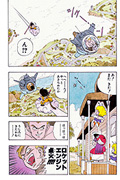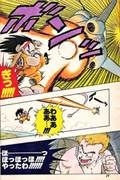With the recent revival of Dragon Ball in Japan, the complete manga series has now been fully released in three formats: the original weekly serialization, the economic tankōbon novels, and the more expensive perfect edition novels. With all these releases spanning the course of two whole decades, it becomes difficult to keep track of what each release contains, and what the actual differences are between them all.
The original serialization is truly a collector’s gem, but can people really be expected to keep hundreds of volumes of phonebook-sized manga lying around? The tankōbon are cheap and easy, but what exactly are you missing out on by buying an inexpensive release? As for the perfect edition, being “perfect” may depend on your own opinion. Is the original source of the manga the “perfect” form or are having corrections needed in order for a release to be perfect? Do you consider these corrections and edits destruction of art? In this feature we will go over each release, explain what has been done at each level of publication, and of course present you with a full visual comparison of an entire chapter!
Weekly Serialization
Dragon Ball was originally published at a rate of one chapter per week in Shueisha’s Weekly Shōnen Jump magazine. Toriyama would submit the artwork and a little blurb about whatever each week, and it would be printed on newspaper-type recycled paper. The pages were about the same size as a typical magazine page, so you would be presented with some nice large images.
All chapters were printed without alterations to the original image, so if it were colored it would be printed in color, and if there were mistakes (as there occasionally were), they too would be left as-is. However, Shueisha had a habit of adding extra stuff to the chapters. Obviously each page is loaded with advertisements along the sides, but even beyond that, extra stuff was added to the manga itself. Each chapter’s title page would have the Toriyama/Bird Studio logo stamped onto it, and usually would contain some sort of blurb about the chapter. For example, chapter 81 (seen below) has “This ain’t Dr. Slump!” and “Gyuun and Goku, Blue’s great pursuit!” printed on the title page, as well as a little “Full Color” special presentation message in the actual image. This text is not available in either the tankōbon or kanzenban (perfect editions).
Furthermore, color has been added to the image in various places. More coloring was added to the backgrounds in many panels, and even the speech bubbles were done in jazzy colors, which actually look pretty decent. This version of the manga was not quite 100% true to Toriyama’s original artwork, but it came pretty damn close, and we are sure many people would want the extra Shueisha material simply as a rarity. However, these books were extremely large, extremely cheap (price and quality-wise), and one-time prints, so the chances of obtaining them now-a-days is pretty close to zero.
Tankōbon
A collection of Dragon Ball chapters, released approximately at a rate of one book every two months, and typically containing 12 chapters. These books are quite small and the pages are made of a higher-quality cheap newspaper-type recycled paper. The quality of the chapters released in the tankōbon really depends on what you are looking for, and what you consider to be a good bargain (approximately $4-5 per book), and what you consider to be pure trash.
These books are printed in pure black and white, so pages that were originally colored come out as being darker than usual and shaded in levels of gray. The majority of the title pages are collected in the back of the book; however, occasionally a title page will be left out completely. The title pages will sometimes have the extra Shueisha text kept on them, and other times they will use the raw image without the text. The actual titles for the chapters are also altered, usually moving them around and printing them in a more solid font. On the other hand, the chapters themselves use the original art as the source, so any extra coloring added by Shueisha is not present, and all mistakes are kept as-is.
This release contains extra images and content from Toriyama, but unfortunately do not have the original comments from the Shōnen Jump index. Overall, this release is really a mixed bag. Sometimes you get that rare added Shueisha text, you get the original art as the chapter source, and there is a pile of extras in there. On the other hand, the print is cheap, the coloring is gone, and occasionally you will get a missing title page.
Kanzenban (Perfect Edition)
These books collect the chapters in the same fashion as the tankōbon, but really give the series the star treatment. The books are of a decent size, approximately 15 chapters per book, and printed using jet-black solid ink on crisp white sheets of paper, with colored pages printed in their full original colors. Although the quality of the book certainly is perfect (albeit at a higher price), the perfection of the actual content is really up for debate.
This release uses Toriyama’s original artwork as the source, with no added Shueisha text on the title pages, and obviously without the extra coloring. All title pages are also present in these books, making the collection truly complete. However, the content has been edited. Errors in the dialog have been corrected, and the subsequent apologies from Toriyama in the following chapters have also been removed. Errors in the images have also been corrected, such as the infamous “WELL COME” sign, which now reads “WEL COME”. There are also some oddities in there, such as the title page for chapter five, which seems to have been completely re-drawn. The final volume includes a new ending to the series, but the original ending has been left out, including Toriyama’s thank you message.
As a definite bonus, the front and back covers of the book contain brand new “modern-Toriyama” style images, but is it worth the price? After all, in addition to all of this, there is… well, nothing. None of the extra images, Toriyama messages or interviews have been kept from either the Weekly Shōnen Jump issues or the tankōbon. On one hand you are getting an excellent quality release of the actual chapters, but on the other hand they are occasionally edited, and there is really nothing else there besides the chapters themselves.
Conclusion
So what is the verdict? Buy all three releases of course!
Ok, so you cannot likely buy the original Jump issues, but both the tankōbon and kanzenban releases are still readily available for purchase, and it really is a tough decision. Both versions have their high and low points, but for us it is going to be the kanzenban in the end. Sure, they have some edits, and yeah the extra material has been removed, but you really do get your money’s worth in sheer quality. However, if you are an absolute purist or simply cannot afford the pricier kanzenban, then the tankōbon might be just what you need!
Visual Comparison
As an example of some of the differences we talked about, here is Dragon Ball chapter 81 in its entirety, in all three forms!
- Weekly Shōnen Jump S61 No.31 – July 14, 1986
- Tankōbon Volume 7: Pursuit!! General Blue – May 13, 1987
- Kanzenban Volume 6 – February 9, 2003
| Weekly Jump | Tankōbon | Kanzenban |
 |
 |
 |
 |
 |
 |
 |
 |
 |
 |
 |
 |
 |
 |
 |
 |
 |
 |
 |
 |
 |
 |
 |
 |
 |
 |
 |
 |
 |
 |
 |
 |
 |
 |
 |
 |
 |
 |
 |
 |
 |
 |
 |
 |
 |
 |
 |
 |
 |
 |
 |
